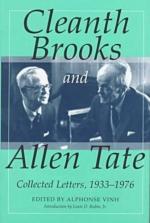|
This section contains 5,135 words (approx. 18 pages at 300 words per page) |

|
SOURCE: "Eliot's Modernism and Brooks's New Criticism: Poetic and Religious Thinking," in Mississippi Quarterly, Vol. 46, No. 1, Winter, 1992/93, pp. 23-37.
In the following essay, Duvall argues that the spiritual values required by Eliot's Modernism and Brooks's New Criticism are fraught with contradiction and lead to a static literature.
Emerging as the dominant critical methodology in America after World War II during a time of enormous expansion in the American university, New Criticism apparently exemplified a democratic pedagogy: any student could learn the skills to become a close reader of literary works. Today, though, it might seem perverse to investigate a movement that repeatedly has been declared passe for at least twenty-five years. William Cain reminds us, however, that no matter what contemporary theoretical perspective from which one works, few would seriously question the usefulness of close reading as a tool of analysis: "So deeply ingrained in English studies are...
|
This section contains 5,135 words (approx. 18 pages at 300 words per page) |

|


